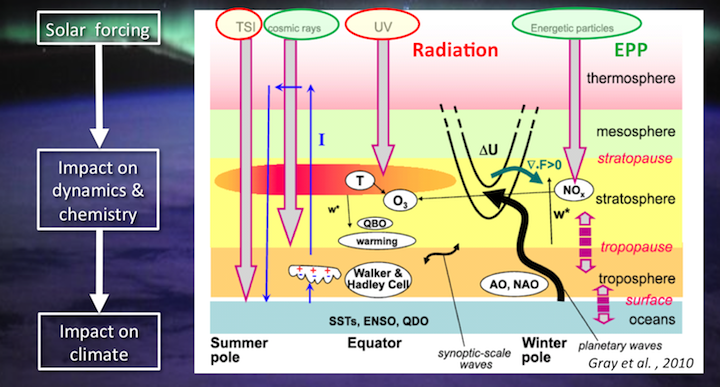The importance of solar forcing on climate has been recognized since decades. However, the atmospheric solar signal and its transfer mechanism(s) remain still uncertain. To address these questions, the international working group SOLARIS (in 2012 renamed to SOLARIS-HEPPA) was created to clarify the effects of solar influence on climate with a special focus on the importance of middle atmosphere chemical and dynamical processes and their coupling to the Earth's surface with state-of-the-art chemistry-climate models (CCMs) as well as mechanistic models and observations. We foster and initiate detailed studies targeting the characterization of the radiative and energetic particle forcing, a better understanding of the transfer and amplification mechanisms responsible for surface climate impacts, as well as on the detection and attribution of the solar-forced climate variability and its impact on predictability.
In addition, SOLARIS-HEPPA aims to provide a platform for the coordination and discussion of solar-related observational and model studies. This includes recommendations for the solar irradiance and particle-induced ionization used to drive middle atmosphere and climate models within e.g. the SPARC-CCMI initiative and the CMIP simulations.
SOLARIS-HEPPA collaborates with a number of other programms and groups such as WCRP-LHA “Explaining and Predicting Earth System Change WG2”, the activities in SPARC, including LOTUS, SNAP, CCMI, DynVar, and SCOSTEP’s PRESTO (Predictability of the variable solar-terrestrial coupling) programme.
The SOLARIS-HEPPA initiative will give a more complete picture of „Solar Influence on Climate“. A primary goal is a recommendation for upcoming IPCC rounds which processes (solar radiation and particles) to include in future climate studies.

Schematic diagram of solar influence on climate (from Gray et al., 2010). Shown are the direct and indirect effects through solar irradiance changes (TSI and UV) with respect to Smax as well as corpuscular radiation effects (energetic particles and GCRs). The two dashed arrows denote the coupling between the stratosphere and the troposphere and the coupling between the ocean and the atmosphere.